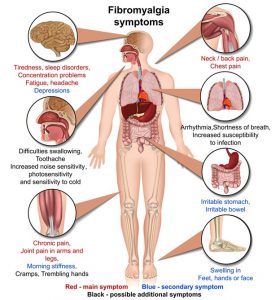Clinical Case Definition
Information for Fibromyalgia Australia is reproduced with the permission of the Canadian National ME/FMS Action Network (2005). Fibromyalgia Syndrome is multifactorial and clinical presentations vary. A recent Australian publication Treatment of fibromyalgia, Kwiatek, 2017 is available on the National Prescriber website. Currently research is underway to develop more detailed clinical markers and to categorise different subsets of Fibromyalgia.
Fibromyalgia (FMS) is a primary chronic pain condition, classified in the WHO International Classification of Diseases: ICD-11 Version: 2019.
It is a complex multisystem physical illness, with chronic widespread pain experienced in the muscles, ligaments and/or tendons that lasts for at least 3 months. Widespread Pain means pain in at least 3 or 4 areas of the body i.e. above and below the waist, and on both sides of the body.
Useful assessment tools to diagnose Fibromyalgia include:
- 2011 Fibromyalgia Michigan Body Map diagnostic tool
- Fibromyalgia Questionnaire, Hauser, 2012
Additional Clinical Symptoms and Signs
Fibromyalgia also has significant other symptoms, which can include:
- Sleep disturbance, non-restorative sleep
- Fatigue
- Musculoskeletal stiffness
- Cognitive dysfunction
Other symptoms can be evaluated using the Fibromyalgia Canadian Multisystem Questionnaire, based on Canadian symptom criteria, 2005)
For ongoing management and to limit disability it is important to identify and monitor all Clinical Symptoms & Signs that contribute to the patient’s burden of illness.
Two or more of these features are usually present in most FMS patients by the time they seek medical attention. On the other hand, it is uncommon for any individual FMS patient to have all of the associated symptoms or signs. As a result of the delayed clinical presentation of FMS patients, symptoms may vary somewhat between patients. The varying patterns of involvement may eventually lead to the recognition of FMS clinical subgroups. These additional clinical symptoms and signs are not required for diagnosis or the research classification of FMS, but they are still important in clinical management.
To support clinicians in managing fibromyalgia, the following clinical symptoms and signs are itemized and described in an attempt to expand the compulsory pain criteria into a working Clinical Case Definition of FMS.
- Neurological Manifestations: Neurological difficulties are often present such as hypertonic and hypotonic muscles; musculoskeletal asymmetry and dysfunction involving muscles, ligaments and joints; atypical patterns of numbness and tingling; abnormal muscle twitch response, muscle cramps, muscle weakness and fasciculations. Headaches, TMJ disorder, generalized weakness, perceptual disturbances, spatial instability, and sensory overload phenomena often occur.
- Neuro-cognitive Manifestations: Some neuro-cognitive difficulties usually are present. These include impaired concentration and short-term memory consolidation, impaired speed of performance, inability to multi-task, and/or cognitive overload.
- Fatigue: There is persistent and reactive fatigue accompanied by reduced physical and mental stamina, which often interferes with the patient’s ability to exercise.
- Sleep Dysfunction: The patient experiences unrefreshing sleep. This is usually accompanied by sleep disturbances including insomnia, frequent nocturnal awakening, nocturnal myoclonus, and/or restless leg syndrome.
- Autonomic and/or Neuroendocrine Manifestations: These manifestations include cardiac arrhythmias, neurally-mediated hypotension, vertigo, vasomotor instability, sicca syndrome, temperature instability, heat/cold intolerance, respiratory disturbances, intestinal and bladder motility disturbances with or without irritable bowel or bladder dysfunction, dysmenorrhea, loss of adaptability and tolerance for stress, emotional flattening, lability, and/or reactive depression.
- Stiffness: It is common for generalized or regional stiffness that is most severe upon awakening and typically lasts for hours, to occur. Stiffness can return during periods of inactivity during the day.

Further Information:
- Fibromyalgia Resource Downloads
- Treatment of fibromyalgia, Richard Kwiatek, 2017
